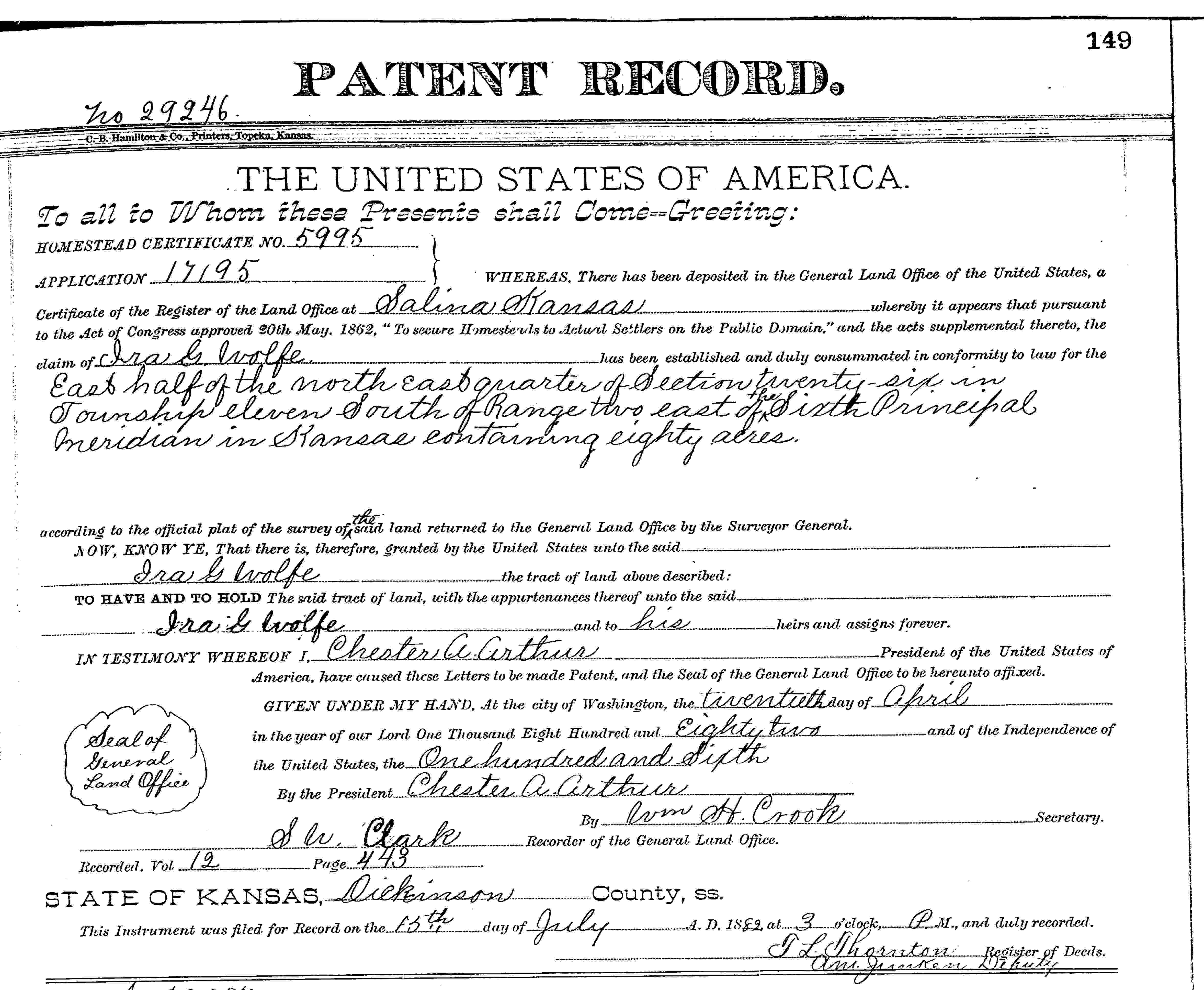
1882 Homestead land patent to Ira G Wolfe,
Dickinson County, Kansas
1882 Ira G Wolfe was granted a patent for 80 acres of land, by president Chester A. Arthur, on April 20. [1]

1883 Ira G Wolfe, unmarried, executed a mortgage for $500, on February 20, payable at the Chase National Bank of New York, from Mariana C Porter of Middlesex County, Massachusetts for 80 acres on East half of the North East quarter of Section 26, Twp 11 South, Range 2, East of 6th PM. On February 8, 1885, Mariana Porter acknowledged full payment of the mortgage.[2] The deed was registered on February 24, 1883. [3]
1885 Ira G Wolfe, unmarried, executed a mortgage for $800, on January 17, from the Travelers Insurance Company in Abilene, Dickinson County, Kansas, for 80 acres on East half of the North East quarter of Section 26, Twp 11 South, Range 2, East of 6th PM, Dickinson County, Kansas. [Photocopy, 1885 Ira G Wolfe, mortgage, first page.] [Photocopy, 1885 Ira G Wolfe, mortgage, second page.] [4] [5]
1885 Ira G Wolfe paid off a mortgage for $500, on February 8, from Mariana C Porter (of Middlesex County, Massachusetts) for 80 acres in Kansas on East half of the North East quarter of Section 26, Twp 11 South, Range 2, East of 6th PM. [Photocopy, 1885 Ira G Wolfe mortgage, paid off.]
1885 Ira Wolfe and Clara Brenizer were married, on February 12, at "Joe Brenizers" by James M Frame. Ira G Wolfe, age 31, was from Abilene, Kansas and Clara Brenizer, age 22, was from Haddam, (Washington County), Kansas. The marriage license record in the Abilene, Kansas courthouse reports that "Joe Brenizers" was in "said county", which would be Dickinson County. The wedding may have taken place at the house of Clara's brother, Jacob Addison Brenizer, who lived in Washington County, Kansas with wife F.E. and daughter N.C Brenizer. Alternatively, it could have taken place at the house of Clara's uncle, John L Brenizer, in Abilene. Here are quotes describing the event.
Mr I.G. Wolfe, of Cheever Twp, and Miss Carrie Brenizer, of Union City, Indiana, were united in the holy bonds of matrimony, last week. The Gazette extends congratulations and wishes the young couple a happy and prosperous journey through life. [6] [7]
Ira G. Wolfe and Clara Brenizer were married on 2-12-1885 by J.M. Frame [Kansas, Dickinson County, Marriage Record, Book A-1, v.1]
Ira Geraldes Wolfe, of Abilene, Kansas, and Clara Verlilia Wolfe, of Union City, Indiana, were joined together in the bonds of holy matrimony at Haddam, Kansas, on the twelfth day of February, 1885, in the presence of J. A. Brenizer. [8].
Marriage license for Ira Wolfe and Clara Brenizer
1885 Ira G Wolfe and wife were granted a warranty, on April 6, by Samuel Page for land at E ½ of N.E. ¼ of Sec. 26.11.2 E in Dickinson County. Samuel Page owned the adjacent lot in section 25. [Photocopy, Indexed in Dickinson County, Kansas Deed Book 6, page 114, but not found there.]
1885 The land that Ira Wolfe warranted was in Section 26 of Cheever Twp, on the east half of the lot labeled Wm Free, shown on an 1885 map of Dickinson County. David Wesley Howard had land in sections 34 and 35 of Cheever Twp, just south of Ira's land. Schoolhouse 37, further to the south, in section 11 of Buckeye Twp, was on land of John S. Chronister. John S. Chronister moved to Kansas with Ira Wolfe and DW Howard. Uncle John L. Brenizer owned 240 acres in section 35 of Cheever Twp, Dickinson County. Just south were the lands of John L. Brenizer's son CM Brenizer. Samuel Page, who gave a warranty for Ira's land on 6 April 1885, had land in section 25 of Cheever. [9]
1885 Ira G Wolfe paid off a mortgage, on April 17, from the Travelers Insurance Company, executed by Ira G Wolfe on January 1, 1885 in Abilene, Dickinson County, Kansas for 80 acres on East half of the North East quarter of Section 26, Twp 11 South, Range 2, East of 6th PM. [Photocopy, 1885 Ira G Wolfe, mortgage release.]
1885 Ira G Wolfe (age 31 farmer) and Clara Wolfe (age 22 born PA and of Ohio); Joseph (age 49 carpenter) and Annie M (age 51 tailor) Chronister (Ira's mother and step-father ); Austin (age 16 carpenter), John (age 13), and Milton (age 11) Chronister; and C.M. Luke (age 12 born PA and of Colorado, Ira's nephew through half-sister Laura Chronister) lived in Cheever Twp, Dickinson County, Kansas. [10] [Photocopy, 1885 census for Dickinson County, Kansas.]
1885 Ira Wolfe, a farmer, and Clara Wolfe (age 23) lived in Garden City, Scott County, Kansas. The adjacent census listing was for Ira's parents and half-brothers, the Chronisters: Joseph, a cattleman (age 49), Anna (age 50), Austin (age 16), John (age 13), and Milton (age 11). The double listing with the census in Dickinson County, above, suggests that Clara and Ira Wolfe moved to Scott County soon after their marriage and that Ira Wolfe's family, the Chronisters, also moved from the Abilene area to Scott County at this time [11] [Photocopy, 1885 census for Scott county, Kansas.]
1885 Ira G Wolfe was elected constable of Scott Township. This indicates that both Ira Wolfe and Joseph Chronister became active in the Scott County government soon after their move. Scott Center (the present day Scott City) was in Scott County, which was organized as a township of Finney County, Kansas. Here are three reports about the election:
A township election was held in Scott county July 7th, and the follow officers elected: Justice - S. W. Case and J. Chronister, Trustee - Charlie Waite, Constable - John Keeve and I. G. Wolf. [12] [Photocopy, 1885 newspaper story suggesting that Scott Township was formed for the purposes of land speculation.]
1885 A township election was held in Scott Center July 7, 1885, and the following officers were elected: Trustee, Charley L. Waite; Treasurer, C.R. Swan; Clerk, M.H. Bailey; Road Overseer, W.E. McLain; Justice of Peace, S.W. Case and Joseph Hollister [Chronister]; Constable Ira J. Wolf. [13]
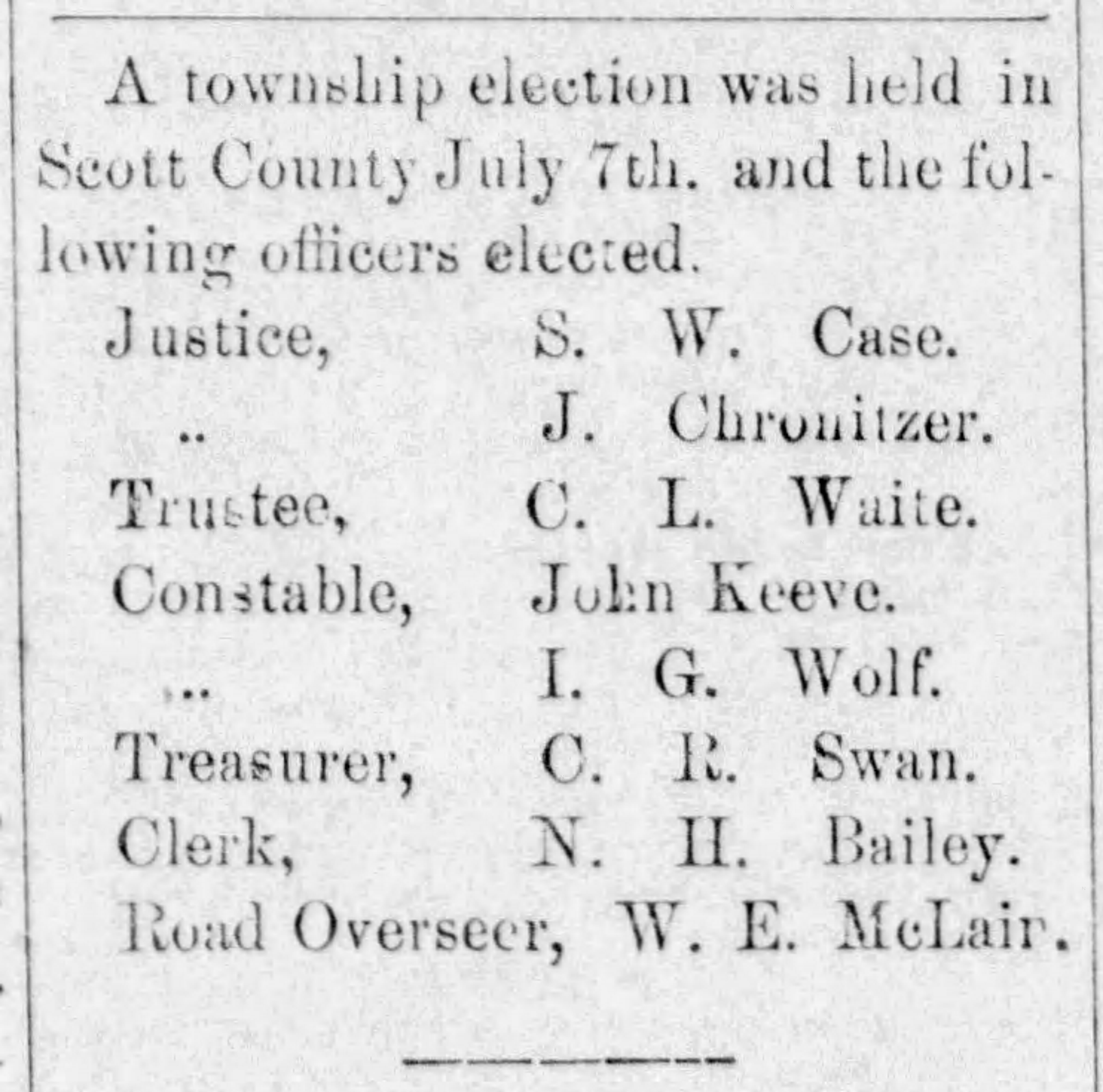 [14]
[14] 
1885 Ira G. Wolfe was named as a witness to a claim for land in Garden City, Kansas.
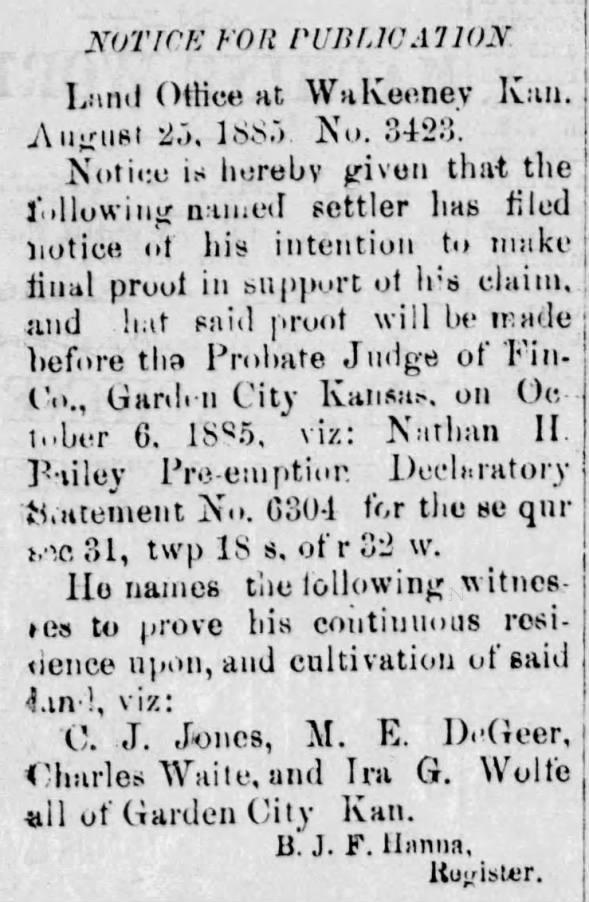
1885 A newspaper notice reported: "Land Office at WaKeeney Kan., Oct. 27, 1885. No. 3639. Notice is hereby given that the following named settler (William G. Hartshorn) has filed notice of his intention to make final proof in support of his claim, and that said proof will be made before Probate Judge Finney Co., at Garden City Kansas … Joseph Chronister, Ira Wolf, W.D. Hartshorn, and Lloyd Selby, all of Garden City, Kansas." [16]
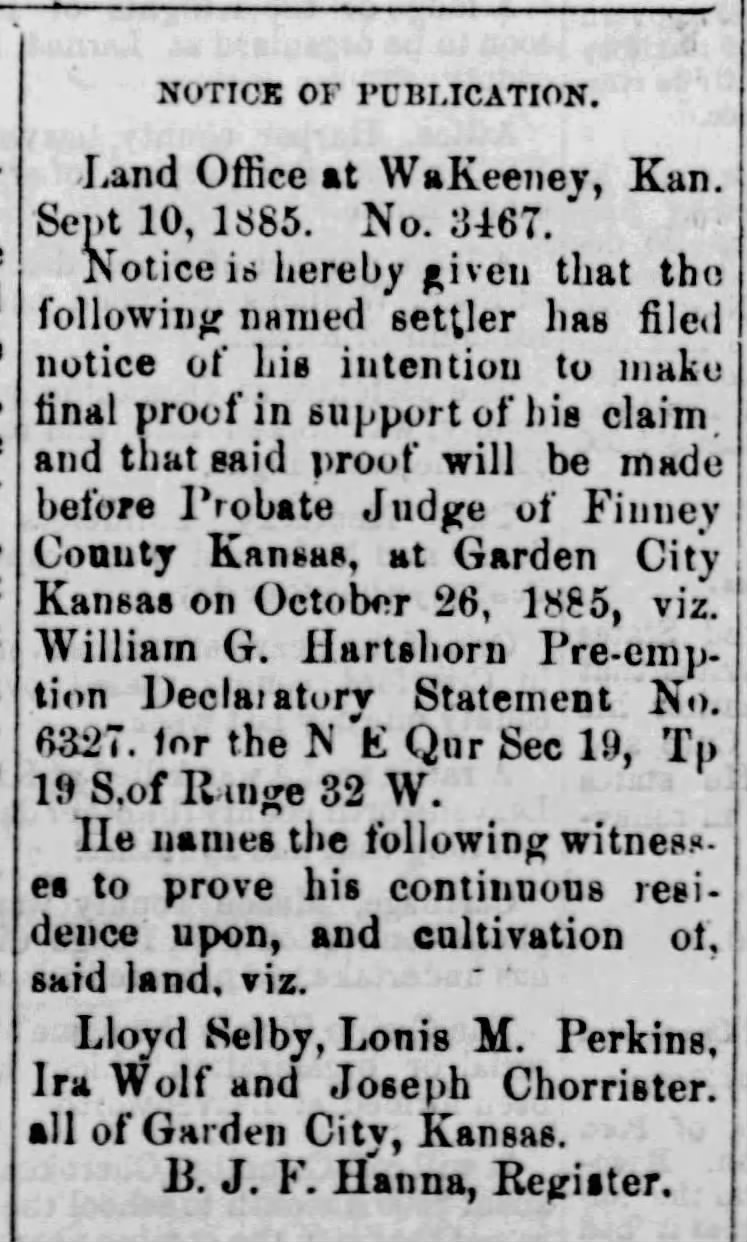
1886 Ira Wolf claimed land in WaKeeney, Kansas.

1886 Ira Wolfe was in the business of "land locating" in Scott County, Kansas, perhaps meeting clients at the post office where Ira's mother was the postmistress (see the notes for Anna Brenizer) [19]:
Mr. Quance came to Scott County in 1886. A significant fact is that he came in company with three other men, but is the only one of the quartet still living in Scott County. That indicates perhaps the proportion of settlers who came out during those hopeful years of the '80s and who actually remained during the hard times that followed. Of the many hundreds who sought homes on the western prairies of Kansas in the early days, it is perhaps conservative to state that not more than one out of four came through the fire of adversity and bore the heat and burden of the day long enough to realize the dream of good fortune. … Andrew J. Quance shipped a wagon and team over the railroad to Garden City, and from that point drove into Scott County. He was a stranger to everybody in this section. At the old postoffice and hamlet of Saratoga he met Ira Wolf, who followed the business of land locating. Under the guidance of Wolf he and his companions found their first claims. Mr. Quance selected as his location the southeast quarter of section 21, township 19, range 31. He built a half dugout and half sod house, with board roof, containing a single room. It was on the 10th of March he arrived in this region. After the house he put up a sod and board stable, and dug a well, finding water at a depth of only thirty-three feet. He also broke out some land the same year.








1886 Ira Wolf was on a committee of 6 appointed to divide Scott County into school districts. "The committee reported, having divided the county into eight school districts. Report accepted, and committee discharged." [28]




1886 A newspaper editorial recounted [34]
Mr. Editor: - Pardon me for interrupting the placid stream of your laborous and monotonous duties by reminding that in the month of June 1885 when Scott City could boast of but two buildings any more pretentious that claim shanties, quite a ripple of excitement was created by the arrival of Mr. Wolf of the neighboring hamlet of Saratoga bringing with him a tall, dignified, elderly gentleman, whom he introduced as Rev. Towne.
The only visitors on that warm summer day before the wandering pilgrim of God, had been a half score of cowboys who after amusing us with reminisences of ranch life were quietly engaged in that classic game of poker and so absorbed in its beauties as they sat upon the green carpet of grass in the rear of the only house in town which was of sufficient altitude to protect them from the scorching rays of the sun that they would not have paused for a moment had not Rev. Towne commenced to relate the exciting adventures he had met with on his way up from Garden. He had learned that Scott City was destitute of religious privileges and in his ardent desire to promote the spread of the gospel to the waste places of the earth he had set out from Garden on foot (as the stage in those days did not boast of making the trip in five hours) carrying in his hand a large carpet sack, containing all his earthly treasures. When about three miles south of Saratoga, almost exhausted by the excessive heat of the unclouded sun, and nearly perishing for the want of water to cool his burning thirst he was without a moments warning; exposed to an attack from a mountain lion which seemed to spring up from the ground and crouching bebeath a mess of tall weeds was ready to spring upon him.
At this critical moment the good man prayed to his heavenly Father for protection; although he believed his prayer was both heard and favorably received yet he came into our midst trembling with excitement. Our youthful card players, by nature kind hearted, sympathizing with the clergyman in his narrow escape from a horrible death mutually agreed that whoever won the game should donate the winnings to pay the preacher. A Mr. Thompson of McPherson who was present generously paid his board bill and Mr. terry, founder of the town of Terry, desiring to participate in the first religious service in our infant town assisted in beating the audience, passing the hat, etc., and thus were the first religious services conducted in Scott county. Pioneer.
1886 Ira wolf was nominated as the Democratic candidate for the register of deeds in Garden City, Kansas. He did not win the election. [35] [36]

Mr. Ira Wolf whose name is before you as a candidate for the office of register of deeds, subject to the action of Democratic convention, is one of our most respected and intelligent farmers, living about five miles south of Scott. Mr. Wolf is a thorough gentleman in every respect and would make an exemplary officer. [38]
Ira Wolf is a candidate for Register of Deeds. Mr. Wolf is one of the most successful farmers in the county, having a well improved place south of town, is an honorable and intelligent gentleman, and would be the right man in the firght place. [39]
1886 A newspaper notice reported [40]
Ira Wolf was up from Saratoga Tuesday morning and reports every thing looking fresh and nice after the rain. He tells us that he will have plenty of feed of all kinds to do him this winter, and the only thing he will have to buy will be his bread and a few potatoes. He is now feasting on roasting-ears.

1886 Ira and Clara Wolfe were involved in several land transactions in Kansas and Colorado near Lamar, Colorado. "Lamar made history in May of 1886 when local renegades stole the Blackwell Station, from railroad mile post 499 and moved it to the location where it now sits in the center of Lamar. Slipping in before the court ordered injunction to protect Mr. Black's right to keep the Blackwell Station, 'Platters' stole the station, moved it three miles west, and tossed the sign aside and mounted a new sign named Lamar." [42] We have found several versions of this story, as might be expected when the various people involved had different perspectives about what happened.
This is quoted directly from a previous version of the website for Lamar [43]
As the rail lines winded westward new towns came into being, some of their own accord, others through the efforts of "town site platters". The far west saw much of these promoters during the seventies and eighties. When a location was selected, though often through connivance, a railway station was built. Thus the story of the founding of Lamar Begins.
There was a station on the Santa Fe Trail known as Blackwell, designated as railroad mile post 499, the distance from Atchison, Kansas. It was merely a small depot and stock yards siding. On either side of the track were the holdings of A. R. Black, a cattleman of very extensive operations, whose home and ranch quarters were located nearby. The location was ideal for running cattle. To the south was an unlimited areas of rich grass land and to the north the Arkansas River with its forest of cottonwood and plum trees which furnished water refuge for cattle during winter weather. A small irrigation ditch furnished water for raising grain crops, prairie hay could be harvested from the low land.
Mr. Black was typical of the prosperous cattleman of his period. To him the vast plains area was only intended for grazing and he had little or no patience with farming. Typical of large land holders he became annoyed with the ever increasing arrival of homesteaders. The railway station gave him easy access to the county seat at Las Animas or occasional trips to Denver, or perhaps to that newer town of Pueblo.
Mr. Black was living in an area which was destined to change. There was a decided movement of population westward which was being taken advantage of by the town promoters. This gentry might not be considered entirely ethical in present day light, but men in the past century were not always endowed with to many qualms. If there was profit to be had in starting a town, a town would be started. During that period the town site business had been flourishing, so flourishing in fact that the promoters had nearly run out of town site possibilities, but an opportunity did present itself in eastern Colorado and that opportunity was Blackwell.
Early in 1866 (sic, perhaps 1886) Mr. Black was approached, it is stated, to donate certain of his lands adjacent to Blackwell as a town site. In return he was to reap a substantial profit from the sale of town lots constituting property which he retained. Mr. Black refused to consider any proposition whatever, although he was threatened that another town would be started close by and his depot moved. Mr. Black considered this a bluff. No one could start a town where would the people come from? Shortly however, the promoters had found a man with title to land in section 31, three miles west, who was willing to sell and did. Worse, yet, the depot was to be moved. Mr. Black immediately boarded a train for Denver, consulted his lawyer and prepared to secure an injunction. The next day was Sunday and since the injunction was issued Monday, Sunday was used by a wrecking crew of the railroad to move the Blackwell depot three miles west to mile post 502. They threw aside the Blackwell sign and exhibited the name Lamar and so Lamar was born, May 24, 1886.
The new city was named after Lucius Quintius Lamar, Secretary of the Interior under Grover Cleveland. The name Lamar was used successfully in order to secure a land office. Thus Lamar came into being with all of the usual fanfare and advertising of the time. Likewise came the people, enticed by the thought of free land, and town lots soared to a new high. For a couple of years Lamar enjoyed a very hectic career. It was the last town to be established in this fashion and it is the youngest town of an consequence on the main line of the Santa Fe. Lamar is the County Seat of Prowers County with agriculture as its main industry.
A Historical Survey Report, commissioned by Lamar, gave a detailed perspective that names Isaac R Holmes, of Garden City, Kansas as a key player in the events. Holmes organized the Lamar Town and Land Company. Note that Ira Wolfe lived in Garden City before moving to Lamar, where he interacted with the Lamar Town and Land Company. This report cites the (no longer existing) website quoted above. [44]
Isaac R. Holmes of Garden City, Kansas was a former Santa Fe land agent and a developer of town sites. He had secured the Government Land Office for Garden City and understood that the establishment of a land office was a necessary first step towards establishing a town. Holmes recognized an opportunity to establish a town in the Arkansas River Valley of southeastern Colorado. Most of the land along the Santa Fe railroad line was already owned by cattle ranchers. Although the southeast quarter of Section 31, Township 22, Range 46 had been deeded to Edward and Bertha L Fitzgerald, Holmes chose this land because it was available for establishing a town site and only three miles from the Blackwell railroad station; the railroad company could sanction its relocation to the new town site. Holmes organized the Lamar Town and Land Company with Colonel John E. Godding. Johnson served as President, Goddard acting as secretary, and Holmes was the general manager. Others associated with the company included D. E. Cooper, M. D. Parmenter, M. L. Swift, Captain Spivey and I. R. Holmes' brother, J. H. Holmes.
The next task was to select a name for the town site. President Grover Cleveland's Secretary of the Interior was Lucius Quintius Lamar, a former U.S. Senator from Mississippi who had been a prominent Confederate cavalry officer. The developers reasoned that the Secretary of the Interior would support the establishment of a federal land office in a town named Lamar.
The developers also needed to etablish a railroad depot at the town site; it was critical that potential buyers of land have easy access to the new town. The closest depot was located in the Town of Blackwell, named for A. R. Black, a prosperous cattleman who operated a large ranch in the area. A small railroad depot had been constructed there, along the Santa Fe Trail, and designated as railroad mile post '499', its distance from Atchison, Kansas. In 1866 (sic) promoters had asked A.R. Black to donate some of his land adjacent to Blackwell for the purpose of creating a new town site. In exchange for the donation of his land, Black could subdivide some of his remaining properth into town lots to sell for building sites. When Black turned down the offer, I. R. Holmes identified land owners three miles to the west in the future town of Lamar who were willing to sell their land (Edward and Bertha L Fitzgerald) and told Black the depot would be relocated to the new town site. Black consulted a Denver attorney and was planning to secure an injunction to prevent the depot from being moved. However, on the Sunday before the injunction was to be issued and while A. R. Black was in Pueblo after receiving a false telegram that required his presence for 'important business'. a railroad crew moved the Blackwell depot to railroad mile marker '502' at the new town site; the railroad cooperated in the move because it profited from the establishment of towns located along its route. A special
excursion train from Garden City, Kansas, carrying prospective buyers, arrived in Lamar at 10 am on May 24, 1886. The opening sale of lots was held, with the town officially founded on that day.The value of the lots sold the first day exceeded $45,000. Within six weeks, the cost of the lots had risen from $200 to $1,500. One real estate agency reported that lots 11 and 12 in Block 18, which is the location of 101-103 North Main Street, sold for $9,000; another lot across the street in Block 17 sold for $1,250. Fred W. Burger bought a site for a hotel but had to initially conduct his business from a tent. He later formed a partnership with Abraham Deeter of Winterset, Iowa and together they opened the first hotel in Lamar. Materials were needed for the construction of buildings; the firm of Spivey & Holmes opened a general merchandising store and lumber yard to respond to the demand. Saloons, restaurants and real estate offices opened their doors to the growing populace. Lamar was described in May, 1886:
Only five short weeks ago there was not a sign of human habitation in sight save a single log building down by the cottonwood belt that fringes the stream. From the river southward a desert-looking plain, partly covered by the short buffalo grass, extended up a gentle incline two or three miles…Today there are five and twenty buildings completed or nearly so; many others are begun and active preparations are making to erect a large number more.
… In July of 1886, both houses of Congress passed a bill that created the Bent Land District and named Lamar as the seat for the land office; I. R. Holmes’ request for an official government land office at his new town site had finally been answered. The office formally opened on January 3, 1887 and was swamped with land purchases the following week.
This is copied verbatim from a website that cites the menu page of the Blackwell Station Restaurant in Lamar.
Three men and the Santa Fe Railroad played an unforgettable part in the birth of Lamar, Colorado during May, 1886.
Lucius Quintus Cincinnatus Lamar, a southern statesman influential in reuniting North and South circa 1860's-70's, was Secretary of the Interior, 1885-1888, and later Associate Justice of the U. S. Supreme Court. Aware of the vast empire growing from Santa Fe's thrusts into the West, Lamar gave personal and departmental support to the rail lines building, particularly to the lengthening section across Kansas into Colorado's Arkansas River Valley.
Concurrently I. R. Holmes of Garden City, Kansas, prospering through real estate ventures along the Santa Fe in his state, organized a company with Santa Fe's A. S. Johnson. These men, with others, owned a deeded quarter of Section 31, Township 22, Range 46, and the group honored the Interior Department friend, Lamar, by giving the property his name, hoping also to have a Land Office here, which did come to pass.
Then there was A. R. Black, pioneer cattlemen and owner of much land on both sides of the railroad. The Santa Fe had placed a small two-stored depot, cattle pens, loading chute and wooden water tank plus side tracks at Black's ranch headquarters. The name--Blackwell--came from that of Black and that of his foreman, MacDowell, combining first and last parts respectively.
The MacDowells lived on the second floor of the depot. Black refused to have a town site on his ranch because of the loss of loading fees from cattle shippers using his station would result. When the Santa Fe threatened moving the station, Black threatened an injunction.
Holmes and company plus the Santa Fe, confident of Interior Department backing, made plans. Late, Saturday, May 22, a telegram called Black to Pueblo on "urgent" business. The Blacks caught the last train west. Evening saw a fully crewed work train, including flat cars, steaming from LaJunta to Blackwell station. In record time the cattle loading facilities, depot with Mrs. MacDowell and her children within, and crewmen walking along side, were on the flat cars and on their way to the new site--Lamar.
By Sunday afternoon, May 23rd, station and sidetracks were ready for expected crowds flocking in on "boom trains" from Garden City and other points east. Since no injunction could be issued on Sunday, lot sales which totalled more than $45,000 by day's end were well under way before legal papers could be readied on Monday. Lamar, Colorado, rose from Blackwell's transplanted chrysalis, on a beautiful May 24, 1886.
The foregoing account is proudly displayed on the menu cover of the Blackwell Station Restaurant in Lamar. It has been reproduced here, with the permission of the owners.--Retyped by Kathy Leigh, 8/9/01
The Santa Fe Railroad had this summary online at one time.
On the Santa Fe Trail there was a station known as Blackwell, designated as railroad mile post 499 (the distance from Atchison, Kansas). This was a small depot with stock yards siding and on each side were the holdings of A. R. Black. Black was a substantial cattleman and his home and ranch quarters were nearby. It was a perfect setup for running cattle, with unlimited rich grass to the south and the Arkansas River to the North. The River offered cottonwood and plum trees and plenty of water and refuge for the cattle during the winter. An irrigation ditch furnished water for grain crops and prairie hay from the low land. Life was good and Mr. Black prospered. The plains offered him the ideal environment for his cattle grazing operation and he was annoyed with farming and homesteaders. His location was perfect access to the county seat Las Animas or Denver and Pueblo.
This good thing he had going was destined to change with the movement of population westward, which the town site platters pushed for, profit being their main objective. The town flourished and began to run out of land to expand onto for town businesses. The town site platters saw the opportunity to expand through Blackwell. In 1866 the platters approached Mr. Black to donate his adjacent land to the depot as a town site. He was to profit from the sale of town lots from the property he retained. He staunchly refused even with their threats that they would start another town close by and move the depot there. Mr. Black thought this was a bluff thinking that they couldn't start a town without people!
The promoters bought land from a man in section 31, three miles west, and the depot was to be moved. Immediately upon learning this Mr. Black boarded a train for Denver to secure an injunction through his attorney. This was a Saturday and the injunction was issued on Monday, too little too late. That Sunday a railroad wrecking crew moved the depot three miles west to mile post 502. They tossed the Blackwell sign aside and exhibited the name Lamar and so Lamar was born on Sunday, May 24, 1886. Lamar was named after Lucius Quintius Lamar, Secretary of the Interior for Grover Cleveland. A land office was secured under the name Lamar. People came to Lamar enticed by the advertising of free land and the town boomed! Lamar was the last town to be established in such a way and the youngest town of a consequence on the main line of the Santa Fe.
A personal biography reports the following [45]
An unusual birth took place beside those rails one night in 1886. I.R. Holmes, a former Santa Fe agent, intended to help populate the young country. Holmes was an ambitious land promoter and developer, and in collaboration with the railroad he planned to hold a land auction at a site just south of the Arkansas River on Monday, May 24, 1886. Both Holmes and the Santa Fe stood to profit if they developed a new town along the young railroad's track. He had advertised the sale widely and arranged for prospective buyers to arrive on a special train from the East the morning of the auction.
A railroad station was essential for the proposed new town. To ensure the success of the sale, the Santa Fe had ordered the relocation of a small station that sat at Blackwell, three miles east of the sale site. However, a small problem arose a few days before the auction date.
An obstinate character named A.R. Black owned the little station and the land it sat on. Possibly with visions of his own for a new town, Black refused to allow the station's removal despite the railroad's authorization. This appeared to be a serious snag, but Holmes, the imaginative promoter, was undeterred.
On May 22, two days before the scheduled sale, Black received a telegram from Pueblo, Colorado, one hundred and ten miles to the west. The mysterious telegram insisted he come to Pueblo for important business that day. Black left as quickly as he could.
Holmes and the Santa Fe knew a court order could not be issued on the following day, Sunday. At one minute past midnight Saturday night, a Santa Fe work train pulled up to the station at Blackwell. The crew woke the astonished telegraph operator who lived upstairs over the station, told him to move out quickly, and began to uproot the building.
They picked up the entire building that night, loaded it onto flatcars, and moved it three mile west to the new town site. A switch was hastily installed in the tracks beside the station the same day, and Holmes met the train carrying his buyers the following morning.
A town was born.
They name the new town after Lucius Lamar, Secretary of the Interior at the time.
Another account is given by Perry Eberhart. [46]
Another account is given by James McTighe. [47]
A children's book has been written about the event. [48]

1886 A newspaper in Lamar reported that "J. W. Myler and Ira Wolf, from Scott, Kansas are putting up a livery stable just back of Loudon & Co., on Front street. The main stable is twenty-eight by fifty-six feet." Dated December 4.
The livery is shown across the street from the train depot, on a Sanborn Fire Insurance map of Lamar dated 1893. Two other liveries were shown on 4th Street. [51]
1887 A newspaper notice reported "D.F. Keller, of Abilene, called yesterday. Mr. Keller has purchased the Ira Wolf half-section of land, south of town and intends to add much to the already valuable improvements of this tract of land. He will fence 100 acres for pasture and stock it with Short-horn cattle of which he now has a small herd. He will also put in a large acreage of corn and other grains and will make a valuable citizen for that section of the county." [52]
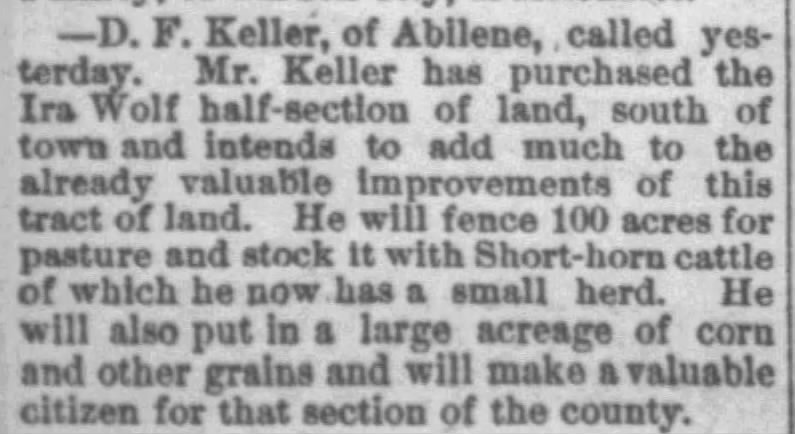

1887 A newspaper in Lamar reported that "We regret to announce the death yesterday of Ethel May daughter of Ira and Clara Wolf the funeral services take place at the residence this afternoon at two o'clock." Dated July 23. [55] funeral Ethel May
1887 A newspaper in Lamar reported that "Mr. Ira Wolf is confined to his residence by illness." Dated August 20. [56] Ira ill.
1892 A newspaper in Lamar reported that an unclaimed letter for Ira Wolf was forwarded by the Lamar Post office. [57] unclaimed letter
1886-1892 Ira Wolf and wife Clara V Wolfe took part in several purchases and sales of land lots in Lamar, Colorado. Several were notarized by Mr. Amint [perhaps Mr Armint, named in the story written about Ira by son Homer]. Two purchases were from the "Lamar Town and Land Company". Some deed records burned in a fire at the courthouse in 1888. The last two, dated December 1887 and June 1888, were notarized for Ira and Clara Wolf from Randolph County, Indiana.
1886 On 1 December, W.C Edwards and his wife sold lots 13, 14, and 15 in block 18 of Lamar, Bent County, Colorado to J.W. Myler and Ira Wolf of Lamar, Bent County, Colorado, for $425. Notarized by James F Whitney. [58]
1887 On 1 February, Ira Wolfe paid $193.13 for 154.5 acres in the SW quarter of section 18, township 19 south of range 32 west in Kansas. [59] A newspaper notice dated February 5 reported the transfer from U.S. government to Ira Wolf at sw ¼ 18-19-34 for $200. [60]
1887 On 4 February, Ira Wolfe and wife Clara V Wolf, of Scott County, Kansas, got a mortgage of $50 from Lebold Fisher and Co for 160 acres of land in Range 32, Scott County. [61]
1887 On 4 February, Ira Wolfe and wife Clara V Wolf, of Scott County, Kansas, got a mortgage of $500 from Catherine M West of Peoria, Illinois for 160 acres of land in Range 32, Scott County. [62]
1887 On 16 March, Ira Wolfe and wife Clara V Wolf, of Scott County, Kansas, sold 160 acres of land in Range 32, Scott County, to David Keller of Dickinson County, Kansas for $1000. A mortgage of $500 was due to Catharine Weis (sic West?). Witnessed by W.E. Eichelberger. [63]
1887 On May 25, Ira Wolf, of the County of Bent, sold lot 13 to Abram Dieter for $200. Notarized by C G Ament. [64]
1887 On July 25, Ira Wolf, of the County of Bent, sold parts of lot 13 and 14, block 17, to John W Holliday for $300. Notarized by C G Ament. [65]
1887 On August 27, Ira Wolf and Clara V Wolf (his wife), of the County of Bent, sold lot 1 in block 10 of Lamar, to J.C. Starr and G.F. Starr of Scott County, Kansas, for $1750. Notarized by C.G. Ament. [66]
1887 On September 12, Ira Wolf of Lamar purchased lot 1 in block 10 from the Lamar Town and Land Company for $60. [67]
1887 On September 19, Ira Wolf and Clara V Wolf (his wife), of the County of Bent, sold lot 10 in block 39 to E.J. Dunn of Carthage, Indiana, for $200. Notarized by C.G. Ament. [68]
1887 On October 17, Ira Wolf, of the county of Bent, Colorado, purchased lots 2 and 3 in block 10 in the town of Lamar, from the Lamar Town and Land Company, for $120. Signed Robert W Steele, vice-president, and witnessed by secretary Jno E Godding. [69]
1887 On December 12, Ira Wolf and Clara V Wolf (his wife), of the County of Bent, sold lot 3 in block 10 to John W Myler, for $400. Notarized by L.D. Lambert for Ira and Clara Wolf from Randolph County, Indiana. [70]
1888 On June 23, Ira Wolf and Clara V Wolf (his wife), of the County of Bent, sold lot 2 in block 10 to Mrs M.E. Dearborn, for $300. Notarized by L.D. Lambert. [71]
1892 Ira Wolf, formerly of the County of Bent, Colorado, signed a quit-claim for land in lots 13 and 14 of Block 17 in Lamar to Maggie Diesem, for $1. The transaction was given in lieu of a warranty deed that had been destroyed in the Los Animas court house fire of 1888. Notarized for Ira and Clara Wolf from Randolph County, Indiana. [72]
1890 Ira Wolf, of Scott County, Kansas, was granted a patent, for 154.5 acres in the SW quarter of section 18, township 19 south of range 32 west in Kansas, on July 28. Granted by president Benjamin Harrison. [73] [74]
1890 Ira Wolfe's mother, Anna Brenizer Chronister, died in Scott County, Kansas. [Photocopy, 1890 Anna Chronister's grave.]
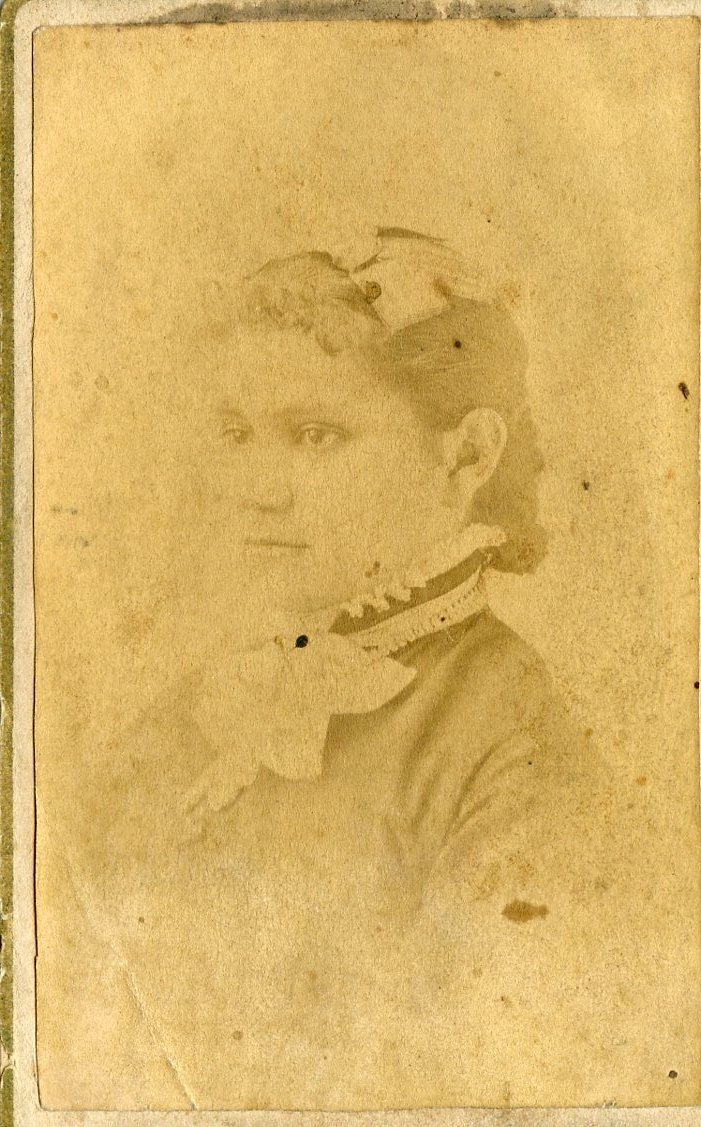
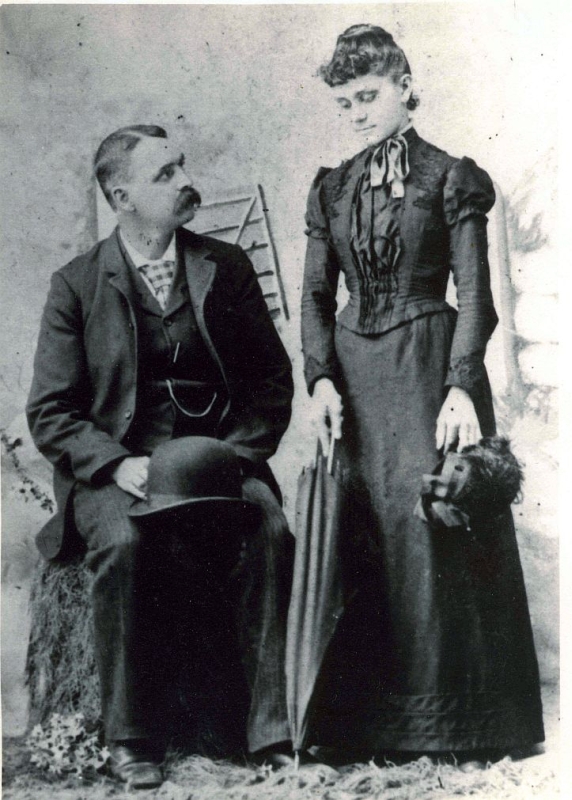
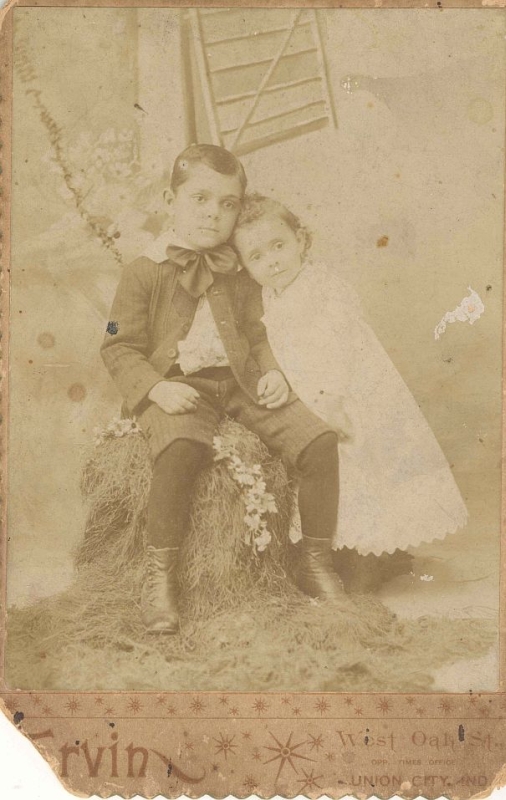
c1893 Clara and Ira Wolfe had photos taken in Union City. [75]
1900 Ira Wolfe (age 47) and Clara (age 37) lived in Union City Village, Jackson Twp, Darke County, Ohio with children Charles (age 14), Grace (age 10), and Homer (age 4). They lived next door to uncle Frank Shall (George F Shawl) across from the Union City high school, as described in son Homer's biography of Ira [See the Personal Notes for Ira Wolfe at this website]. Frank Shawl lived with his wife Anna M (Anna Brenizer was Clara Brenizer's sister), three daughters, and mother-in-law Sarah A (Weigel) Brenizer. Ira Wolfe was a railroad laborer. Aunt Anne and Grandmother Brenizer were dressmakers. Uncle George (Frank) was a carriage blacksmith. Son Charles was a farm laborer. Both families owned their houses with mortgages. Neither was a farmhouse. They likely lived on Sycamore Street, based on his mother's address on that street in 1900. [76] [77]
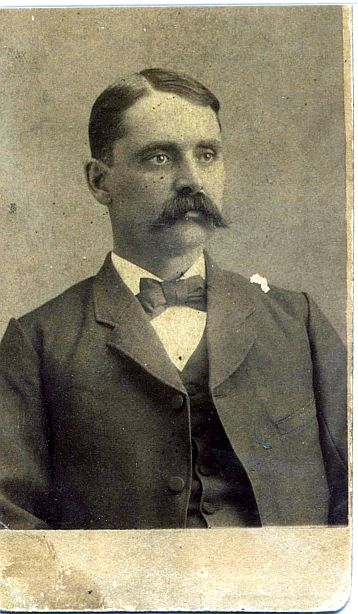
1901 John Franklin Wolfe, son of Ira G. Wolf and Clara Brenizer, was born on March 12 in Union City, Darke County, Ohio. [78]
1902 Ira, Clara, and Chas. Wolf were listed at Route 2 in the 1902 Union City, directory. [79]
1903-05 Ira purchased and sold lots in Union City.
1903 Ira purchased lot 498 in Union City. The Greenville Journal, Greenville, Ohio, Mar 19, 1903. [80]
1903 Ira purchased lot 498 in Union City. The Greenville Democrat, Greenville, Ohio, Mar 18, 1903. [81]
Ira sold lot 477 in Union City. The Greenville Democrat, Greenville, Ohio, Feb 15, 1905. [82]
1904 Son Charles M. Wolfe and Petrovna Jane Pickett were married on September 5 in Darke County, Ohio. His parents Ira G. Wolfe and Clara V. Brenizer, were named on the license. [83] [84]
1905 "A.E. Wittstock, who is superintendant of the mechanical department of the new ice plant at Alachua … Frank Shawl formerly of this city, will be permanent superintendant, as Mr. Wittstock expects to leave …" [Frank Shawl was Clara's brother-in-law, see also 1907 entry below][85] [Photocopy, Newspaper notice.]
1905-07 Ira Wolfe's family had moved to Gainesville, Florida by July: Miss Grace Wolfe gave a nice recitation of "Old Glory" at the Fourth of July celebration in North Gainesville, among other events. [86] [Photocopy, Newspaper notice.] [Photocopy, Newspaper notice.] [Photocopy, Newspaper notice.]
1906 Ira G Wolfe moved from Gainesville to Paradise, Florida. This was confirmed by a newspaper subscription: "Ira G Wolfe, who recently moved from this city to Paradise, called on Saturday and ordered the Sun at the latter place." [87]

1907 Daughter Grace Wolfe was a successful teacher in Gainesville. [88] [Photocopy, Newspaper notice.] [Photocopy, Newspaper notice.]
1907 "After a residence of several years in North Gainesville, Mr and Mrs. Frank Shawl with their family, have removed to Alachua. Mr Shawl has accepted a lucrative position with the ice company at that point." [Frank Shawl was Clara's brother-in-law][89] [Photocopy, Newspaper notice.] A history of at the website for the City of Alachua reports:
On April 12th, 1905 the City of Alachua was officially incorporated and had a population of 526. By 1912 it had three hotels: the Sheffield Hotel; Transient House; and a second Transient House. In 1914 Alachua had two banks, three hotels, a number of stores ranging from a fruit stand to a large, well-stocked department store, ice plant, electric light plant, waterworks, two cotton gins, two grist mills and bottling works. The electric light and waterworks plant began operating in 1913. Electricity cost $1 per month for the first 300 watts and $1.25 for 300-500 watts. The cost of water was $1 per month "for the first opening and 25 cents for each additional opening."
1907-08 Clara and Ira Wolfe were listed as charter members of the University City Church of Christ in Gainesville, Florida. [History] Ira and Clara were charter members of the University City Church of Christ in Gainesville, Florida. [90]
1908 Niece Edith Shawl [Frank Shawl's daughter] visited Clara Brenizer Wolfe in Gainesville. [Photocopy, Newspaper notice.]
1908 Daughter Grace Wolfe had moved out of town as a schoolteacher, but visited. William Jennings Bryan was running for president. [Photocopy, Newspaper notice.] [Photocopy, Newspaper notice (Grace is named at the bottom of the article).]
1908 The Shawl girls were growing up. "Misses Edith and Minnie Shawl, two attractive young ladies of Alachua, were visitors to the city Sunday, stopping with their sister [aunt], Mrs Ira Wolfe." [91]

1909 Homer Wolfe was listed among students in the sixth grade and John Wolfe was listed in second grade as earning a mark of "excellent" during the term in the Gainesville graded schools. The movies cost 10 cents. [92]
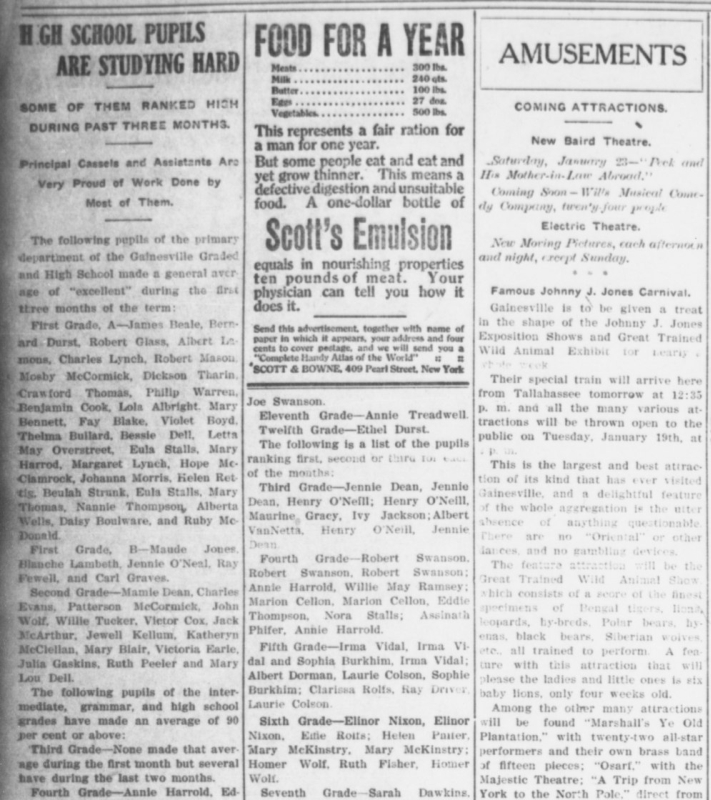
1909 The real estate market was getting better and Clara and Ira Wolfe sold land. [Photocopy, Newspaper notice (see bottom).]
1909 Niece, Edith Shawl, married Mr Hampton Register. [Photocopy, Newspaper notice.]
1909 Daughter Grace Wolfe was a teacher at Cherry Sink School, with a large enrollment. [Photocopy, Newspaper notice.] [Photocopy, Newspaper notice.] [Photocopy, Newspaper notice.]
1910 Clara (age 47) and Ira (age 56) Wolfe lived in Gainesville, Florida with children Grace (age20), Homer (age 13), John (age 8), and Faith (age 6). Ira Wolfe worked as a carpenter and had been married twice. Clara had had 7 children, 5 alive. Clara's aunt Sophia (Weigle) English (age 65 or 68) was in the household. Knowing about widow Aunt Sophia English helped us to identify the parents of Clara's mother, Sarah A. Weigle. [93]
1911 Son Homer Wolfe signed a receipt in Gainesville, Florida, for a meat company, on December 30. This supports the timeline from Homer's story, which reports that the family lived in Florida at this time.
c 1915 The family moved back to Darke County, Ohio about this time.
1916 Ira Wolfe died on August 14 in Greenville, Darke County, Ohio. There were several reports about his death. [94] [95]
1916 Ira Wolfe death certificate
1916 Ira Wolf, son of Anna Brenizer and Mr. Wolf, died in Greenville, Darke County, Ohio on August 14. Charles Wolf was the informant for his death certificate. [96]1916 Obituaries for Ira Wolfe: [Transcription, 1916 Ira Wolfe Obituary.] [Photocopy, Ira Wolfe Obituary A1 (align with next two photocopies).] [Photocopy, Ira Wolfe Obituary A2.] [Photocopy, Ira Wolfe Obituary A3 (align with prior two photocopies).]
1916 More obituaries for Ira Wolfe: [Photocopy, 1916 obituary B.] [Photocopy, 1916 obituary C.] [Photocopy, 1916 Obituary in Florida.]
1916 Page from diary of Hazel Grill noting Ira's death. [Photocopy, Personal journal of Hazel Grill, who lived in Darke County, (bottom left page).] [97]
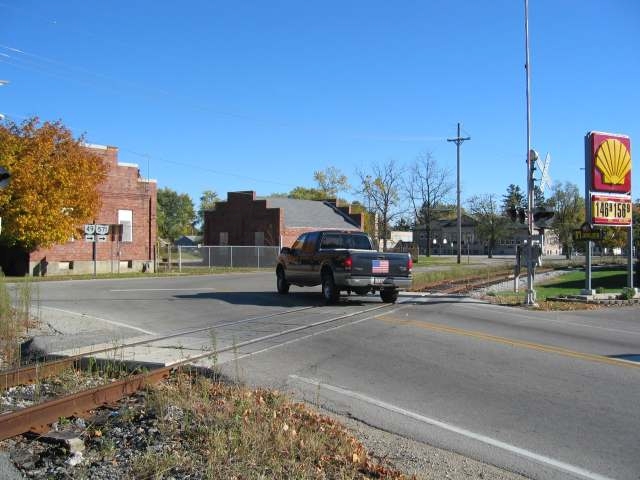
1917 Clara V Wolfe (widow of Ira), Homer (installer at 654 Reibold Building), Grace B (stenographer at 654 Reibold Building), and John (clerk at 654 Reibold Building), lived at 610 W River, Dayton, Ohio. [98] [99]
1918 Clara V Wolfe (widow of Ira), Homer (rubberworker), Grace B (stenographer), and John (clerk at 654 Reibold Building), lived at 610 W River, Dayton, Ohio. [100]
1919 Homer M (assembler), Grace B (stenographer at 117 D Perry), John, Faith G, and Clara Wolfe (widow of Ira) lived at 121 South Creighton Ave, Dayton, Ohio. [101]
1920 Clara Wolfe (age 57) lived in Dayton, Montgomery County, Ohio with children Homer (age 23, a student at bible college), Grace (age 30, a typist), John (age 18, office labor at Elective Manufacturing), and Faith (age 16). [102] [103]
1920 A notice was posted in The Lamar Register of Lamar Colorado naming Ira Wolf and other officers of "The Lamar Town and Land Company" concerning the title to lots 5 and 6 in block 16 of Lamar. [104]
1921 Grace B, stenographer, and John, clerk, and Faith G, clerk, and Clara Wolfe, widow of Ira, lived at 402 W Edgewood, Dayton, Ohio. [105]
1922 Clara Wolfe (widow of Ira), Faith G (clerk), Grace B (stenographer at The Dayton Airless Tire Company), Homer N, and John F (clerk at 334 N Taylor) lived at 402 W Edgewood, Dayton, Ohio. [106]
1925 Clara Wolfe (widow of Ira) lived at 231 N Williams, Dayton, Ohio. Ranald M Wolfe (student) lived at the same address. Charles Wolfe (driver) lived with Petrovna at the same address. [107]
1925 Miss Grace Wolfe and Mr. Charles H. Wilson were married on August 23, 1925 by Howard Schug, minister of Church of Christ, at Taylor County, Texas. Witness Mrs. Clara Wolfe. [108]
1926 Clara Wolfe (widow of Ira) lived at 231 N Williams, Dayton, Ohio. Ranald M Wolfe (student) lived at the same address. Charles Wolfe (driver) lived with Petrovna at the same address. [109]
1928 Clara Wolfe, widow Ira Wolfe, lived at 2223 N Peak Ave, Dallas Texas. [110]
1930 Clara Wolf (age 67, born in Pennsylvania, widowed), mother, lived in Dayton, Montgomery County, Ohio, in a household with Chas Wolf (age 44), Petrovna Wolf (age 45), Gladys Wolf (age 16), and Ranad Wolf (age 22). Clara Wolf's parents were both born in Pennsylvania. [111] [112]
1930 Clara Wolfe, widow of Ira Wolfe, lived at 2223 N Peak Ave, Dallas Texas. [113]
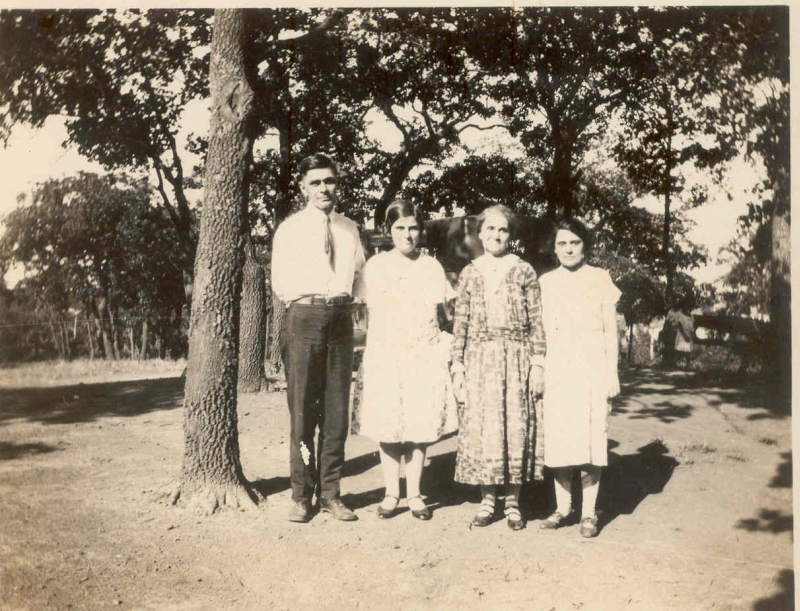
1936 Clara Wolfe, widow Ira Wolfe, lived at 2223 N Peak Ave, Dallas Texas. [115]
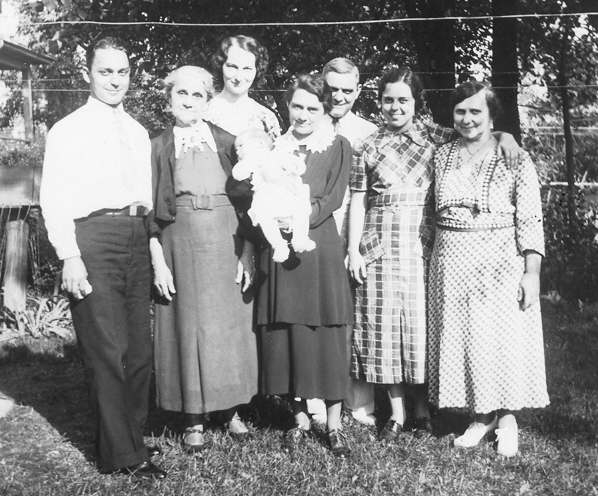
1936 Clara and daughter Grace Wolfe visited Clara's grandson Ranald Wolfe for a four generation picture in October.
1937 Clara's sister Anna Mary reported that Clara Wolfe was living in El Paso, Texas, in a letter to grand-daughter Mildred.
c 1938-39 Clara Wolfe lived with daughter Grace Wolfe Wilson in Dallas Texas. Homer’s family lived together in the same household, perhaps about 1938-39. [116]
1940 Clara Wolfe, lodger, age 77, born in Pennsylvania, widowed, lived was a lodger at 47 Riverview Blvd., Bradenton, Manatee, Florida, in a household with Ellen Hampton (age 73), and Grace W Wilson (age 50). The highest grade of school she had completed was Elementary school, 8th grade. [117] [118]
1942 Clara Wolfe died on September 17 in Dallas, Texas.
Funeral services will be conducted Tuesday at 2 p. m. from the Fraze funeral home in Union City for Mrs. Clara Wolfe, 80, a former resident of Union City, who died Thursday at her home in Dallas, Texas. Mrs. Wolfe, formerly Clara Brenizer, left the Union City community about 30 years ago. The husband of the deceased, Ira Wolfe, will be remembered as having been killed in Greenville approximately 32 years ago. Surviving are a cousin, J. B. Eichelberger, 115 Franklin street, Union City, O.; three sons, Charles, of Dayton, John and Homer, of Dallas; two daughters, Mrs. Grace Wilson, of Dallas, and Mrs. Faith Betts, of Ocala, Fla. Mrs. Wilson and John will accompany the body to Union City arriving over the New York Central at 8:05 p. m. today. Friends may call at the funeral home until the hour of the service. Burial will be in the Union City cemetery. [119] Funeral Services were at Weever Chapel, E. Weever Funeral Home, 2533 McKinney Ave., Dallas, Texas. [120]

1942 The death of Mrs Clara Wolfe was recorded on September 17, in Dallas, Texas at age 79 years 11 months 3 days. Her mother's name was listed as Sarah Wise (sic), should be Sarah Weigle [Mary Wise was her grandmother on the Brenizer side]. [123] [124]
1942 Grace Wolfe Wilson wrote a poem eulogy Clara Wolfe. [Photocopy, Poem.]
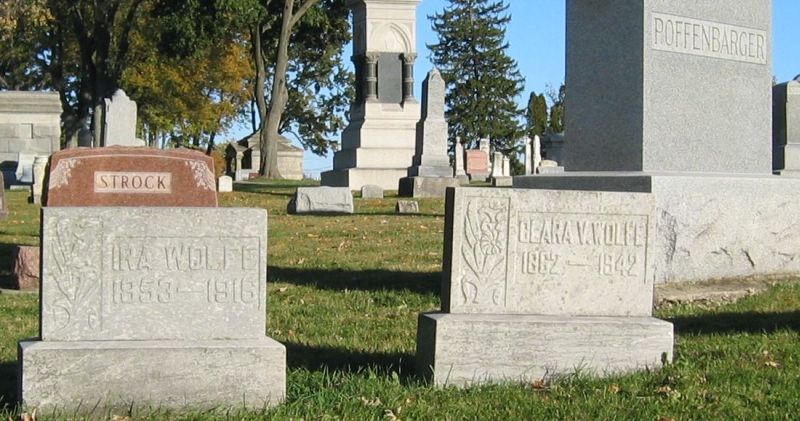
1942 Clara Wolfe and Ira Wolfe were buried at the Union City cemetery, in Indiana. [125]
1942 Grandson Ranald Wolfe wrote to son Charles Wolfe when Clara Wolfe died. [Photocopy, Letter from Ranald to Charles Wolfe when Clara died, Page 1.] [Photocopy, Letter from Ranald to Charles Wolfe when Clara died, Page 2.]
1942 Clara Wolfe's brother, Jacob Brenizer, wrote a letter to Grace Wolfe expressing sorrow at the death of Clara [Photocopy, 1942 Clara's brother Jacob Brenizer's letter to Grace Wolfe.]:
Received your sad wire of Dear sisters death so unexpected as I had not heard of her illness. Sorry I am so far away impossible to come to you to be with you in your bereavement. Nellie (Jacob's daughter) lost her husband in the Gulf his boat a tanker was torpedoed by a sub July the 9th. She worried so much I sent her to Chicago to visit friends to take her mind away from her troubles. I am feeling as usal awful hot here every day. Give my love to the Boys and Charley Alls my sympathy to All Write me soon as to particulars. from your ever remembering uncle Jack (Jacob) Brenizer. #123-6th Av. Jacksonville Beach, Florida.
1942 Clara Wolfe's sister-in-law Mattie, the widow of her brother John Brenizer, wrote a letter to Grace expressing sorrow at the loss [Photocopy, Mattie (widow of Clara's brother John) Brenizer's letter to Grace Wolfe, 1942.]:
My dearest Miss grace - Just a few lines to say I am so sorry to hear of your Mother's death. I really loved her as a sister even tho we never met but I have her letters she had written me & they were so sweet I want to keep them as a memory. The piece in the Gospel Broadcast was so sweet & it brought back sad memories for me but I can only say I do know how to Sympathize with you all when we loose love ones it makes us all grieve. do wish I had knowsn her better but it was impossible Iukie just felt as if she knew her & every day she reads the piece and carried it for her teacher to read also I have let several of my friends read it. it was such a beautiful tribute to her. Now I don't want you al to forget us on the children account. & let me know the address of the others I sent your bro John a card hope he gets it. I must close & you write us often please. With all my love and sympathy . Your Aunt Mattie p.s. please call me Mattie.
1949 Daughter Grace Wolfe Wilson wrote two poems as a tribute: [Photocopy, Poem for Clara Wolfe by Grace Wolfe.] [Transcription, Poem for Clara Wolfe by Grace Wolfe.]
1957 Mrs Grace Wolfe Wilson died on November 9, at age 68, in Dallas, Dallas County, Texas. She was born on June 24, 1889, in Union City, Indiana, daughter of Ira G Wolfe and Clara Brenizer. [126]
1958 Several of the children of Ira and Clara Wolfe gathered at Colorado Springs, Colorado.
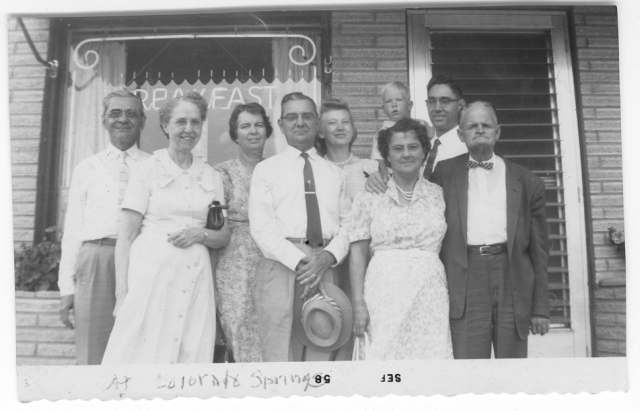
1972 Faith Geraldine Betts applied for social security. Faith, daughter of Ira G Wolfe and Clara V Brenizer, was born on October 4, 1903 in Union City, Ohio. [127]
Research Notes:
1890-91 Ira J. Wolfe, possibly this Ira, was listed in the Kansas City, Kansas Directory. R. L. Polk Co., 1890 at r[esidence] 306 s[outh] 5th. [128]
C. G. Armint was named in court cases involving water rights near Lamar, Colorado. This might refer to Mr. Armint, named in the biography of Ira G Wolfe by son Homer Wolfe, perhaps the same Charles G Amint who notarized several of the deeds in Lamar for Ira Wolfe.
In a biographical account of Ira Wolfe, son Homer Wolfe wrote that Ira Wolfe had been cheated in a business venture by Mr. Armint in Prowers County, Colorado. We looked at deed books in the courthouse in Prowers County during a recent return drive from Olympia Washington back to Michigan. We found deeds showing that Ira Wolfe and J.W. Myler had purchased land in 1886 in Bent County [now Prowers], Colorado. Then Ira sold land on 10 March and 25 July, 1887, with C.G Ament as notary, in Bent County, Colorado. On 27 August and 19 September, 1887, Ira Wolf and Clara V Wolf sold land, with C.G. Ament as notary. On 12 September, Ira Wolf purchased land from the Lamar Town and Land Company. In December, 1887, Ira and Clara Wolf of Randolph County, Indiana sold land to John Myder in Lamar, Colorado, with Mr. Lambert as notary.
Mr. Arment appeared in the court record several times in Prowers County. He was known as C.G. Ament in other documents. History was kind to Mr Amint. He and his family are remembered in biosketches as great engineers and developers of irrigation throughout the west. Our prior searches failed to find Mr. Ament because Homer Wolfe had spelled the name as Armint in the biographical story about Ira G Wolfe.
C.G. Armint was an agent for the Colorado Land and Water Company, which developed irrigation ditches and sold land with perpetual water rights in Prowers County, Colorado. One purchaser, R.L. Adams, sued the company for [failure of] performance of contract. "ln an action against an irrigation company to compel specific performance of a contract to furnish water it, appeared that the promoter of the company employed an agent [Arment] to solicit subscriptions. After the corporation was formed, the promoter, who was then president of the company, wrote to the agent acknowledging that the contracts entered into by him before the corporation was formed were binding upon it, but ordered him to make future contracts for water on a different basis. Held that the corporation had adopted the contracts so as to be bound thereby and could not afterwards change their terms."
The land of appellee [Adams] was some six miles from the line of the canal and he with others in the same vicinity similarly situated and under contracts with appellant constructed a lateral ditch from the canal to their lands. As shown by Mr Arment (appellant's agent) in the fall of 1890 appellee tendered to him the money in payment of his note and demanded a deed for the water right. He said ‘He came to me to settle up for the water and get his water deed and contract’. He tendered the money to me but l preferred to have it deposited in the bank. And appellee and he went to the bank, made the deposit and instructed the cashier to pay it to appellant when it delivered to the bank a deed of the form and character conceded by the agent to be the conveyance agreed upon. A deed was sent by the company which was rejected by appellee and shown by all the evidence to have differed materially from the one contracted for. The quantity of water conveyed was 1.08 cubic feet per second instead of 1.44 reducing it by about one fourth and the time the water was to be furnished in each season was reduced nearly one half. It does not appear that the company at any time rescinded or denied the validity of the contracts, at all times expressing a willingness to take the agreed price. ln a letter written by the president to Mr Arment, his agent, on November 12, 1890, he said: ‘Regarding parties of whom you wrote as having long since contracted for water at the old price, $800, I will say this company raised the price to $1,000 on or about Oct 15th; but this did not apply to any previous obligations, and parties who had previously contracted with you at $800 will be entitled to water at that price, if closed for at once. On December 23, 1890 Mr Clarke the general manager wrote the agent: ‘Ii have to advise you that the price of water from the canal of this company has been placed at $800 for each full paid perpetual water right for eighty acres, consisting of the continuous flow, during one hundred days of the irrigating season, of 1.08 cubic feet per second.’ There was no important controversy in regard to the facts. Appellant Insisted on its right to deliver deeds modified as to time and quantity. Appellee insisted upon a compliance with the contract, brought this suit to compel specific performance, and for damages in the loss of crops for the failure to deliver the water. The question of damage was tried to a jury that found for the appellee in the sum of $240. [129]
Biosketches of the family of C.G. Armint/Ament report [130]:
Edward Glenn Ament was born in the state of New York September 18, 1806, and died November 22, 1888. When a babe his parents removed from Olean, N. Y., to Hardin county, Ky., where they resided about ten years, when they moved to Sullivan county, Ind., and there in the woods, E. G. Ament helped to clear up a small farm. In 1823 or thereabouts he journeyed overland with a neighbor in a "prairie schooner" to Peru, Ill. While young he resolved never to taste liquor and he never did. His face was set like a flint against these and other like evils and he succeeded in preventing all his boys from using liquor and tobacco. From Peru he went to Chicago in company with the surveyors of the Illinois and Michigan canal and was there two years, from about 1824 to 1826. For one year he was with a Mr. Clybourn and with a Mr. Kinzie one year. There he studied arithmetic evenings and some of the other common English branches, and at the end of his sojourn there, with $200 in silver in a mitten in a trunk in a dugout canoe, the product of his own handiwork, he returned to Peru via the Desplaines and Illinois rivers without mishap except that he was occasionally overhauled by an Indian who hoped to find liquor aboard. His parents then lived at Peru. His father, John Ament, was a cabinet maker. His mother was a stanch Methodist. She with the six sons and one daughter left Kentucky and came to Indiana where they were under the guardianship of herself and Charles Clark, her brother, both staunch Methodists, which accounts for at least four of the boys being enthusiastic Methodists. The sons were named as follows : Edward, Hiram, Justus, Calvin, John and Anson, the latter dying in the army. Calvin was a minister and the others followed farming.
After certain experiments at the Galena lead mines and subsequent experiments at farming in Bureau county, E. G. Ament located permanently in 1830 in Kendall county. III, about fifty miles south of Chicago. His first marriage united him with Emily Ann Harris, by whom he had two children, and he later married Mary Luce, who bore him eight children. Mary Luce was a Baptist, born in the state of New York in the vicinity of Martinsburg. a sincere, conscientious Christian woman. Soon after marrying his first wife there was an Indian uprising, and the settlement being warned by Shabbona, he with his wife and with other settlers fled to Plainfield, where there was a stockade, and thence went to Fort Dearborn, Chicago. He received a land warrant for one hundred and sixty acres of land for his services in the Black Hawk war. The earliest preserved list of voters in Chicago appears to contain thirty-seven names, E. G. Ament being one.
The district school house was located on the Ament farm in Kendall county, and campmeetings were held in their woods. The prairie was twenty miles wide at that point between the Fox and Illinois rivers. Log houses were scattered along the skirts of the timber ; deer, wild geese, prairie chickens and other wild game were plentiful in those days. The residence was about a mile from Fox river, on the south side, on the old Chicago and Ottawa stage road. When the California gold fever broke out in 1849, E. G. Ament fitted out an expedition headed by Hiram Ament to invade the gold fields, going by way of the isthmus.
There appears to be two tribes or families of Aments in the United States ; one north, the other south; the former being chiefly located in the state of New York, the latter in Tennessee. The one south claims that their ancestors came from Holland near the borders of France. The nativity of the ancestors of the former is not stated, but all are supposed to be of French descent. E. G. Ament died on the 22d of November, 1888, at the age of eighty-two, and is interred at Pavilion, about four miles south of the old homestead in Kendall county.
C. G. AMENT, president of the Golden Drift Mining Company, was born November 5, 1851, at the old homestead in Kendall county, Ill. His occupation has been varied, from reclaiming large tracts of arid lands, to developing the virgin prairies into high priced productive farm lands. He was educated in high schools and institutes of learning, and is a gentleman of retiring manners and is a worthy citizen of high moral character and Christian integrity. His marriage united him with Miss Emma Sininis, a highly cultured lady, and they are blessed with three children, two of whom are boys.
Mr. Ament is a firm believer in irrigation, and was instrumental in obtaining signatures to the project which was to convert many thousand acres of otherwise worthless land into rich, productive farms which today are teeming in wealth in fat growing kinc. He left his rich pastures and beautiful meadows in Colorado, all under a double water right, to superintend the irrigating proposition of the beautiful and productive valley of Grants Pass, Ore., of which he is the leading factor. The Aments are all hustlers and have a happy faculty of succeeding.
C. W. AMENT, the general manager of the Golden Drift Mining Company, is a brother of C. G. Ament, whose father, E. G. Ament, now deceased, came to Chicago in 1824, when there were but three houses in the town. This was before the Indian war of the white settlers with the Sacs, Foxes and the Black Hawks and in the days when the plow was drawn by the faithful ox-team, in the perilous period when the trusty rifle was always a factor of the plowman's safety ; as the swish of an Indian's arrow or the flash of an old flint lock from ambush was not an uncommon occurrence. It was during these early days that Shabbona, the old Indian chief, advised all of the white families of the Fox River valley of the pending massacre by the coming redskin warriors : a fact which made old Shabbona's name revered and was ever after a shibboleth of good cheer and great reverence. Shabbona often camped by the "old spring" at the Ament home, always being the modest recipient of fat mince and apple pies from the hot bake-oven of the ever faithful wife and mother Ament, as well as a heaping milkpan of doughnuts done to a brown.
C. W. Ament was born in Kendall county, September 17, 1842. and started on the road of life by taking up the common school branches in an old log school house situated on the farm; after which he attended high school at Plainfield and later attended Fowler Institute. He married Miss Lucy J. Preston by whom two children were born, Marion C. and Winifred L. Ament, both of whom are living. Later in life he became a large rancher in New Mexico and finally took up mining, and after years of experience he decided to purchase a placer property with a great future, if such could be found, and finally selected the Dry Diggings. Having conceived the idea of installing large hydraulic pumps for mining purposes after a most careful investigation of all possibilities, he decided to construct a dam across Rogue river, which he regards as the crowning effort of his life.
M. C. Amint, superintendent of the Golden Drift Mining Company, was born in Livingston county in 1869 and is the eldest child of C W. and Lucy J. (Preston) Ament. His childhood days were spent near Chicago, Ill., and in Topeka, Kans., and his education was obtained principally in Washburn College and the Topeka Business College. He married Miss Edith Cavell, an English lady, by whom he has two children. .*\ close application for years in the Santa Fe shops and many other mechanical and electrical undertakings gave him his broad initiation into the occupation of which he is now an acknowledged expert.
In politics Mr. Ament has alwavs been a pronounced Republican, but not a partisan nor an office seeker, preferring to devote himself wholly to his business interests. Since coming to Grants Pass in December, 1901, he has been a member of the board of trade and is identified with other organizations for the upbuilding of the place.
As superintendent of the construction of the Golden Drift dam. Mr. Ament has had abundant opportunity to utilize his inventive and mechanical genius. This gigantic dam. which is seven Hundred feet over all, is twenty and one-half feet high and one hundred and twenty feet wide at the bottom, with a converging thirty-degree slope, to fourteen feet wide at the top of the dam. The other dimensions are as follows : Four hundred feet across the river ; an eighty-foot abutment ; a raceway one hundred and twenty feet in width ; and a wing dam three hundred and fifty feet in length (the latter being for the purpose of protecting the power house). The total possible power output is forty-one thousand horse-power, of which six thousand horse-power will be used lor hydraulicing at the mines and the balance for irrigation and for sale to outlying industries. In the near future, large electric generators will be put in and other improvements made for transmission purposes.
The company owns eleven hundred acres of auriferous or gold bearing gravel, forming one of the largest and richest placers in the entire state of Oregon, the banks running from twenty to ninety feet in depth. The plant will be ready for operation by 1904, and will then be operated night and day, power being thereby secured sufficient for the removal of six thousand yards of gravel per day. Under the supervision of M. C. Ament, sawmills were installed for the company and a sufficient amount of lumber (about two million, five hundred thousand feet) sawed for the completion of the plant. The steam shovel used for excavating the raceway was built under his personal supervision and its signal success voices the wisdom of this undertaking. Mr. Ament's ability along mechanical lines has been of great assistance to him in the trying duties assigned him, and his services as a skilled mechanic liave Ix'en of the greatest value to the company and have enaljled its directors (of whom he is one) to place the plant upon a solid financial and practical working basis. This great enterprise will prove a giant stride in the mining world that will prove the true value of force with which to uncover the upper granite bed rock and disclose the vast age-hidden treasure of incalculable value in the silent mountain peaks.
Grant's Pass Irrigation Scheme. GRANT'S PASS, Or., Jan. 17. (Special.) The Advance Electric Power & Irrigating Company, which is a branch of the Golden Drift Company, or that portion of the enterprise which has In view the irrigating of Grant's Pass and surrounding country, has begun its work here. C. G. Ament, president of the company, and a man who has had an experience of several years in Colorado in similar enterprises, has charge of the work. The surveys for the ditches have already been made. All of the farms and orchards for a distance of nine miles down the Rogue from here will be reached by the ditches. Mr. Ament says he feels confident that irrigation will work as great benefits, if not greater, for this country than it has worked for Colorado. [131]
Further research about Mr. Amint:
Another court case addressed the change in name of the company. Colorado Land and Water Company versus Rocky Ford. (Colo App.) 34 Pac. 580. (not seen)
[132]Bent/Prowers County land records listing of photocopies:
3898 C-cover
3899 1886_1201_C-254_Edwards_to_Myder_and_Ira_Wolf_Block18
3900 1886_1201_C-254_Edwards_to_Myder_and_Ira_Wolf_Block18
3901 1886_1201_C-255_Edwards_to_Myder_and_Ira_Wolf_Block18
3902 1886_1201_C-255_Edwards_to_Myder_and_Ira_Wolf_Block18
3924 D-Cover
3925 1887_0223_D-Amity_Canal_and_Reservoir_to _CG_Amint_A
3925 1887_0223_D-Amity_Canal_and_Reservoir_to _CG_Amint_B
3897 A-cover
3892 1887_0304_A-347_Ira_Wolf_to_Deeter_Lots13-14_Block_17
3894 1887_0304_A-347_Ira_Wolf_to_Deeter_Lots13-14_Block_17
3895 1887_0304_A-347_Ira_Wolf_to_Deeter_Lots13-14_Block_17
3896 1887_0304_A-347_Ira_Wolf_to_Deeter_Lots13-14_Block_17
3903 A-cover
3904 1887_0725_A-378_Ira_Wolf_to_Holliday_Block_17
3905 1887_0725_A-378_Ira_Wolf_to_Holliday_Block_17
3919 A-cover
3920 1887_0827_A-423_Ira_Wolf_Clara_to_Starr_Lot1_Block 10
3886 A-cover
3887 1887_0906_A-71_Arment
3888 1887_0906_A-71_Arment
3906 C-cover
3907 1887_1115_C-Annie Sterling-Ament_291
3908 1887_1115_C-Annie Sterling-Ament_291
3909 1887_1115_C-Annie Sterling-Ament_292
3910 1887_1115_C-Annie Sterling-Ament_292
3927 A-Cover
3928 1887_0912_A-576_Lamar_Town_and_Land_Company_to_Ira_Wolf_Lot1_Block10_60
3932 1887_0912_A-576_Lamar_Town_and_Land_Company_to_Ira_Wolf_Lot1_Block10_60
3933 1887_0912_A-576_Lamar_Town_and_Land_Company_to_Ira_Wolf_Lot1_Block10_60
3911 A-cover
3912 1887_0919_A-387_Ira_Wolf_Clara_to_Dunn_Lot10_Block 39_200
3913 1887_0919_A-387_Ira_Wolf_Clara_to_Dunn_Lot10_Block 39_200
3921 A-cover
3922 1887_1212A-493_Ira_Wolf_Clara_to_Myler_Lot3_Block 10
3923 1888_0414A-450_Ira_Wolf_Clara_to_Dearborn_Lot2_Block 10
3914 C-cover
3915 1888_0322_C-Annie Sterling-Ament_300
3916 1888_0322_C-Annie Sterling-Ament_301
3917 1888_0322_C-Annie Sterling-Ament_302
3918 1888_0322_C-Annie Sterling-Ament_303
[1] United States Bureau of Land Management Patent, [US_BLM Abstract], [Website Image].
[2] Family Document, Dickinson County Library microfilm.
[3] Dickinson County, Kansas, Deed V-100.
[4] Family Document, Dickinson County Library microfilm.
[5] Dickinson County, Kansas, Deed 6-24.
[6] Newspaper, Gazette, (Abilene, Kansas), February 20, 1885.
[7] Kansas Genealogical Society, The Treesearcher, 19(1977):109, reports a date of 12 Feb 1885.
[8] Family Document, In a letter dated 11 Aug 1943 from son Homer to son Charles, Homer recorded information from a family bible.
[9] John F Fuller, Map of Dickinson County, Kansas (Ramsey, Millet & Hudson, 1885), [LibraryOfCongress Map], [LibraryOfCongress].
[10] Kansas State Census Collection, 1855-1925, [AncestryRecord], [AncestryImage].
[11] Kansas State Census Collection, 1855-1925, 1 March, 1885, [AncestryRecord], [AncestryImage].
[12] Newspaper, Scott County News (Scott County, Kansas), Wednesday April 28, 1886, Vol. 1, #5, reporting from the "Western Times" of July 8th, 1885.
[13] Leola Howard Blanchard, Conquest of Southwest Kansas (Wichita, Kansas: Eagle Press, 1931), 337, [InternetArchive].
[14] Newspaper, The Western Times, Garden City, Kansas, July 8, p4 c2, reports names as J. Chronitzer and I. G. Wolf, newspapers.com.
[15] Garden City Irrigator, Garden City, Kansas, August 13, 1885, page 5, [NewspapersClip].
[16] Newspaper, The Western Times, Garden City, Kansas, November 4, p1 c6, newspapers.com.
[17] The Western Times, Garden City, Kansas, September 23, 1885, page 1, [NewspapersClip].
[18] The Scott County Lever, Scott City, Kansas, December 30, 1886, page 4, [NewspapersClip].
[19] Scott County Historical Society, History of Early Scott County (1977), 195, [GoogleBooks].
[20] Scott County Herald, Scott City, Kansas, July 10, 1886, page 2, [NewspapersClip].
[21] Scott County Herald, Scott City, Kansas, July 17, 1886, page 2, [NewspapersClip].
[22] The Scott County Lever, Scott City, Kansas, November 4, 1886, page 2, [NewspapersClip].
[23] The Scott County Lever, Scott City, Kansas, November 11, 1886, page 2, [NewspapersClip].
[24] The News Chronicle, Scott City, Kansas, July 29, 1886, page 4, [NewspapersClip].
[25] Scott County Herald, Scott City, Kansas, September 18, 1886, page 2, [NewspapersClip].
[26] The Scott County Lever, Scott City, Kansas, December 30, 1886, page 4, [NewspapersClip].
[27] Scott County Herald, Scott City, Kansas, February 5, 1887, page 3, [NewspapersClip].
[28] Newspaper, Scott County Herald, Scott City, Kansas, April 22, p2 c1, newspapers.com.
[29] Scott County Herald, Scott City, Kansas, April 22, 1886, page 2, [NewspapersClip].
[30] The News Chronicle, Scott City, Kansas, May 5, 1886, page 2, [NewspapersClip].
[31] Newspaper, Scott County News (Scott County, Kansas), May 5, 1886, Vol. 1, #6.
[32] Scott County Herald, Scott City, Kansas, August 7, 1886, page 3, [NewspapersClip].
[33] The News Chronicle, Scott City, Kansas, May 26, 1886, page 3, [NewspapersClip].
[34] Newspaper, Scott County Herald, Scott City, Kansas, May 20, p3 c4, newspapers.com.
[35] Newspaper, The Western Times, Garden City, Kansas, July 22, p4 c1, newspapers.com.
[36] Newspaper, The Western Times, Garden City, Kansas, July 29, p1 c3, newspapers.com.
[37] Scott County Herald, Scott City, Kansas, July 17, 1886, page 2, [NewspapersClip].
[38] Newspaper, The Western Times, Garden City, Kansas, July 15, p1 c2, newspapers.com.
[39] Newspaper, Scott County Herald, Scott City, Kansas, September 18, p2 c2, newspapers.com.
[40] Newspaper, The Western Times, Garden City, Kansas, Augusts 5, p4 c3, newspapers.com.
[41] The Western Times, Garden City, Kansas, August 5, 1886, page 4, [NewspapersClip].
[42] Family Document, original website is no longer available.
[43] Lamar, Colorado website, no longer has text quoted above, [URL].
[44] Hoehn Architects, Cultural Resource Survey, Architectural & Historical Survey Report No longer online, (2012), 14-18.
[45] Gary Penly, Rivers of Wind: A Westward Boyhood Remembered, 11, [URL].
[46] Perry Eberhart, Ghosts of the Colorado Plains (1986), 126, [URL].
[47] James McTighe, Roadside history of Colorado (1984), 49-50, [URL].
[48] Mary Peace Finley (Author), Judith Hunt (Illustrator), The Midnight Ride of Blackwell Station, [URL].
[49] Bent County Register, Lamar, Colorado, December 4, 1886, page 3, [NewspapersClip].
[50] Chronicling America, Historic American Newspapers, Library of Congress, [NewsChroniclingAmerica].
[51] Sanborn Fire Insurance Map from Lamar, Powers County, Colorado (Thrift Press, 1929), [LibraryOfCongress], [LibraryOfCongress].
[52] Newspaper, Scott County Herald, Scott City, Kansas, April 9, p3 c1, newspapers.com.
[53] Scott County Herald, Scott City, Kansas, April 9, 1887, page 3, [NewspapersClip].
[54] The News Chronicle, Scott City, Kansas, March 17, 1887, page 3, [NewspapersClip].
[55] Chronicling America, Historic American Newspapers, Library of Congress, [NewsChroniclingAmerica].
[56] Chronicling America, Historic American Newspapers, Library of Congress, [NewsChroniclingAmerica].
[57] Chronicling America, Historic American Newspapers, Library of Congress, [NewsChroniclingAmerica].
[58] Prowers County, Colorado Courthouse, Deed Book C-254, [Image].
[59] Scott County Kansas Courthouse, Receipts Book 1-228.
[60] Newspaper, Scott County Herald, Scott City, Kansas, February 5, p3 c3, newspapers.com.
[61] Scott County Kansas Courthouse, Mortgage Book 2-001.
[62] Scott County Kansas Courthouse, Mortgage Book 3-489.
[63] Scott County Kansas Courthouse, Deed Book 2-441.
[64] Prowers County, Colorado Courthouse, Deed Book A-347, citing Vol. 2, Pg 434, No 3200, [Image].
[65] Prowers County, Colorado Courthouse, Deed Book A-378, [Image].
[66] Prowers County, Colorado Courthouse, Deed Book A-423, [Image].
[67] Prowers County, Colorado Courthouse, Deed Book A-576, [Image].
[68] Prowers County, Colorado Courthouse, Deed Book A-387, [Image].
[69] Prowers County, Colorado Courthouse, Deed Book 9-116, [Image].
[70] Prowers County, Colorado Courthouse, Deed Book A-493, [Image].
[71] Prowers County, Colorado Courthouse, Deed Book A-450, [Image].
[72] Prowers County, Colorado Courthouse, Deed Book 15-084, Quit-claim book, [Image].
[73] United States Bureau of Land Management Patent, [US_BLM Abstract], [Website Image].
[74] Scott County Kansas Courthouse, Patent Book 5-255, a copy made in 1920.
[75] Family Document, Files of Newman and Carol Wolfe, copied from Virginia Betts's photos.
[76] United States Federal Census, 1900, [FamilySearchImage], [FamilySearchRecord].
[77] United States Federal Census, 1900, [AncestryImage], [AncestryRecord].
[78] Ohio, U.S., Births and Christenings Index, 1774-1973, [AncestryRecord].
[79] 1902 Directory of Rural Routes No's 1, 2, 3 and 4 5 and 6 Out of Union City, Indiana, [Darke County Ohio Web no longer available].
[80] The Greenville Journal, Greenville, Ohio, Mar 19, 1903, page 5, [NewspapersClip].
[81] The Greenville Democrat, Greenville, Ohio, Mar 18, 1903, page 3, [NewspapersClip].
[82] The Greenville Democrat, Greenville, Ohio, Feb 15, 1905, page 3, [NewspapersClip].
[83] Ohio, County Marriages, 1789-2016, Darke, K-560, [FamilySearchImage], [FamilySearchRecord].
[84] Family Search, Ohio, County Marriage Records, 1774-1993, [AncestryImage], [AncestryRecord].
[85] Newspaper, Gainesville Daily Sun (Gainesville, Florida), June 16, 1905, page 8.
[86] Newspaper, Gainesville Daily Sun (Gainesville, Florida), Florida, July 6 and Dec 29 1905, June 27 1907.
[87] Newspaper, Gainesville Daily Sun (Gainesville, Florida), March 5, 1906, page 8.
[88] Newspaper, Gainesville Daily Sun (Gainesville, Florida), July 7 and Aug 26 1907.
[89] Newspaper, Gainesville Daily Sun (Gainesville, Florida), Dec 12, 1907, page 2.
[90] Family Document, copied from Church of Christ website active in 2005.
[91] Newspaper, Gainesville Daily Sun (Gainesville, Florida), January 12, 1909, page 8.
[92] Newspaper, Gainesville Daily Sun (Gainesville, Florida), January 18, 1909, page 4.
[93] United States Federal Census, 1910, [AncestryImage], [AncestryRecord].
[94] Find A Grave Memorial at Ancestry.com, [AncestryRecord].
[95] Find A Grave Memorial 65041525, [FindAGrave].
[96] Ohio Department of Health, Ohio, Death Certificates, [FamilySearchImage], [FamilySearchRecord].
[97] Hazel Grill Journal [Darke County Ohio Web no longer available].
[98] Williams Dayton Directory (Cincinnati, Ohio: 1917), 1415, [AncestryRecord], [AncestryImage].
[99] Video history of the Reibold Building, Dayton, [URL].
[100] Williams Dayton Directory (Cincinnati, Ohio: 1918), 1521-22, [AncestryRecord], [AncestryImage].
[101] Williams Dayton Directory (Cincinnati, Ohio: 1919), 1525, [AncestryRecord], [AncestryImage].
[102] United States Federal Census, 1920, [FamilySearchImage], [FamilySearchRecord].
[103] United States Federal Census, 1920, [AncestryImage], [AncestryRecord].
[104] Colorado Plains to Peaks Historic Newspapers, [Colorado Newspaper Archive].
[105] Williams Dayton Directory (Cincinnati, Ohio: 1921), 1561, [AncestryRecord], [AncestryImage].
[106] Williams Dayton Directory (Cincinnati, Ohio: 1922), 1584, [AncestryRecord], [AncestryImage].
[107] Williams Dayton Directory (Cincinnati, Ohio: 1925), 1493, [AncestryRecord], [AncestryImage].
[108] Texas, County Marriage Records, 1837-1965, [FamilySearchImage], [FamilySearchRecord].
[109] Williams Dayton Directory (Cincinnati, Ohio: 1926), 1510, [AncestryRecord], [AncestryImage].
[110] Worley's Dallas City Directory 5015643 (Dallas, Texas), 404048072, [AncestryImage], [AncestryRecord].
[111] United States Federal Census, 1930, [FamilySearchImage], [FamilySearchRecord].
[112] United States Federal Census, 1930, [AncestryImage], [AncestryRecord].
[113] Worley's Dallas City Directory 5009546 (Dallas, Texas), 403459852, [AncestryImage], [AncestryRecord].
[114] Family Document, Files of Carol Wolfe.
[115] Worley's Dallas City Directory 4836401 (Dallas, Texas), 385418978, [AncestryImage], [AncestryRecord].
[116] Personal Communication, Conversation with Ira Wolfe, descendant of Clara's son Homer.
[117] United States Federal Census, 1940, [AncestryImage], [AncestryRecord].
[118] United States Federal Census, 1940, [FamilySearchImage], [FamilySearchRecord].
[119] Newspaper, Union City Times-Gazette, Monday, September 21, 1942.
[120] Clara Wolfe obituary [Darke County Ohio Web no longer available].
[121] Palladium-Item, Richmond, Indiana, September 22, 1942, page 10, [NewspapersClip].
[122] U.S., Newspapers.com Obituary Index, 1800s-current, [AncestryRecord].
[123] Texas Deaths, 1890-1976, Death certificates, [FamilySearchImage], [FamilySearchRecord].
[124] Texas, Death Certificates, 1903-1982, [AncestryImage], [AncestryRecord].
[125] Find A Grave Memorial at Ancestry.com, [AncestryRecord].
[126] Texas, Death Certificates, 1903-1982, [AncestryImage], [AncestryRecord].
[127] U.S., Social Security Applications and Claims Index, 1936-2007, [AncestryRecord].
[128] 1890 Kansas City, Kansas Directory (R. L. Polk Co., 1890), [AncestryRecord].
[129] T.M. Robinson, Reports of the Decisions of the Court of Appeals of the State of Colorado, Vol. 5 (1895), 190, [HathiTrust].
[130] Chapman Publishing Company, Portrait and Biographical Record of Western Oregon, (Chicago: 1904), 710, [HathiTrust].
[131] The Sunday Oregonian, Portland, January 18, 1903, [URL].
[132] Reports of the Decisions of the Court of Appeals of the State of Colorado, Volume 3, [URL].